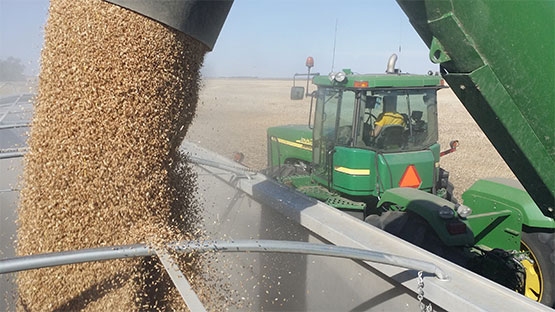
It’s been a busy last two months in grain markets with prices trying to parse through both production and political uncertainty. If it’s one thing the markets don’t particularly like, it’s a vacuum of knowledge, but that’s what we’re dealing with now. While the trade and political issues remain in full force, USDA did its best in the August Crop Production and WASDE reports to offer some clarification. It may not have been the clarification most producers wanted to see, but it was a number, nevertheless.
We’ll get started with the biggest surprise and work from there.
Soybeans
Without a doubt, the biggest surprise coming out of the August Crop Production numbers was USDA’s yield estimate on soybeans. August is traditionally the first time that USDA uses something other than a computer model in making their guess, and it resulted in a number that was a massive two bushel per acre higher than what the trade was looking for. At 51.6 bushels an acre, it would also be the fourth largest upside deviation from the trend line since 1990; right behind 1992, 1994, and 2016. When taken over nearly 90 million harvested acres, you end up with far more production than the trade needed or wanted. Add to that the fact that USDA assumes existing trade policy continues through marketing year end, and you get a carryout of 785 million bushels.
To put that number in perspective, the previously largest realized year ending stock is the 574 mbu that was seen in 2006/07. The largest number ever estimated was 655 mbu, an estimate made by USDA in June of that same year.
There’s no way to know if this is a completely accurate number. It will undoubtedly change as we go through the remaining 12 months of the 2018 marketing year. However, it is the number that we will have to work up or (hopefully) down from and regardless that is going to take some time. Accordingly, USDA dropped the midpoint on its marketing year average price down to $8.90 a bushel.
One last note on soybeans, there are a lot of questions about how U.S. prices compare to Brazil’s prices at present. It’s important to remember that right now, there is not a published quote for shipment of beans from the plains to the PNW port. However, there are offers of beans for shipment out. If you compare the price of delivered into the major Chinese port of Dalian (include freight and tariff charges), Brazilian beans are roughly $1.30-$1.50 per bushel CHEAPER to the buyers. Looking at offers out in November, which would be peak U.S. harvest, and that difference widens out of $1.82 per bushel.
In short, if and when there is finally a sign that the tariff situation is ending, prices (and basis!) should snap up pretty fast. However, as of today, no one has a good estimate on how long this situation might last.
Corn
Mixed results for corn in the August WASDE, although ultimately it could have been far worse. USDA raised their yield estimate on corn, now at 178.4 bushels an acre. That was about two bushel above the trades expected prediction and 1.8 bushels better than last year’s record crop. Illinois, Indiana, Nebraska, Ohio, North and South Dakota are all expected to improve on last year’s crop with Iowa coming in nearly identical to last year. The only states expected to decline are Minnesota, Missouri, and Kansas. Obviously not great news, but USDA was able to eat up a lot of the extra supply with additional demand. The balance sheet still increased, now at 1.6 billion bushels. That’s a large number, but it’s definitely headed in the right direction compared to where we’ve been. USDA projects a marketing year average price of $3.60 per bushel at the midpoint. This is lower than last month but still 20 cents better than the projection for the 2017 crop.
Globally, things look fairly positive as well, although the problem in soybeans is likely to keep a cap on prices. USDA did raise projected 2018/19 world ending stocks by 3.53 mmt from last month, but that’s still 34.84 mmt less than the 2017 crop year. It’s also a five year low stock to use ratio at 11 percent. Only three years were lower: 1973/74, 1995/96, and 2011/12. Now, again, the soybean stocks are going to keep a shadow over all grains; however, it does offer some strong support to corn going forward.
Wheat
It’s been a long time since wheat has been on the market with the most positive news, but that’s the situation we found ourselves in with the August WASDE report. Numbers are still tough, however, at 935 mbu carryout, USDA was 50 mbu less than their July estimate. It would also be the lowest stocks in about three years if realized. There’s no mistaking that this is still a big number, or that there is some tendency for wheat stock projections to grow as the marketing year goes on. I would suggest, however, that many times that’s due to a slow export pace. That could still very well be the case this year, and in fact, I’d suggest that export pace is going to be the key to the wheat market period.
The reason for this is that globally, wheat stocks are finding themselves in a bit of a conundrum. Total world stocks are large, but declining. USDA this month is pegging them at 258.96 mmt (for reference, that’s 9.5 billion bushels!), which is 14 mmt less than the 2017 year.
The decline is due to several various reasons but primarily, the EU is experiencing a variety of weather issues while Ukraine and Russia are both expected to drop exports compared to last year. Australia is still early in the season but is expected to pile on a third year of drought in the larger producing southeast corner. The combination of problems means the U.S. has the best chance in a long time of chewing through some of these bushels.
I don’t think there’s any doubt that producers are experiencing a difficult year, especially in the Northern Plains. Chinese tariff policies will have a disproportionate impact in much of our trade territory and it’s really going to change the way producers handle grain at harvest. In many areas, farmers should look at whether or not it makes more sense to haul corn and wheat in early and keep beans for delivery later in the year. That’s very uncommon in Minnesota, North Dakota and Wisconsin, but I think it’s something that needs to be very closely examined.
As always keep your eyes open and look further down the board. There are some better pricing opportunities developing for the 2019 year!



